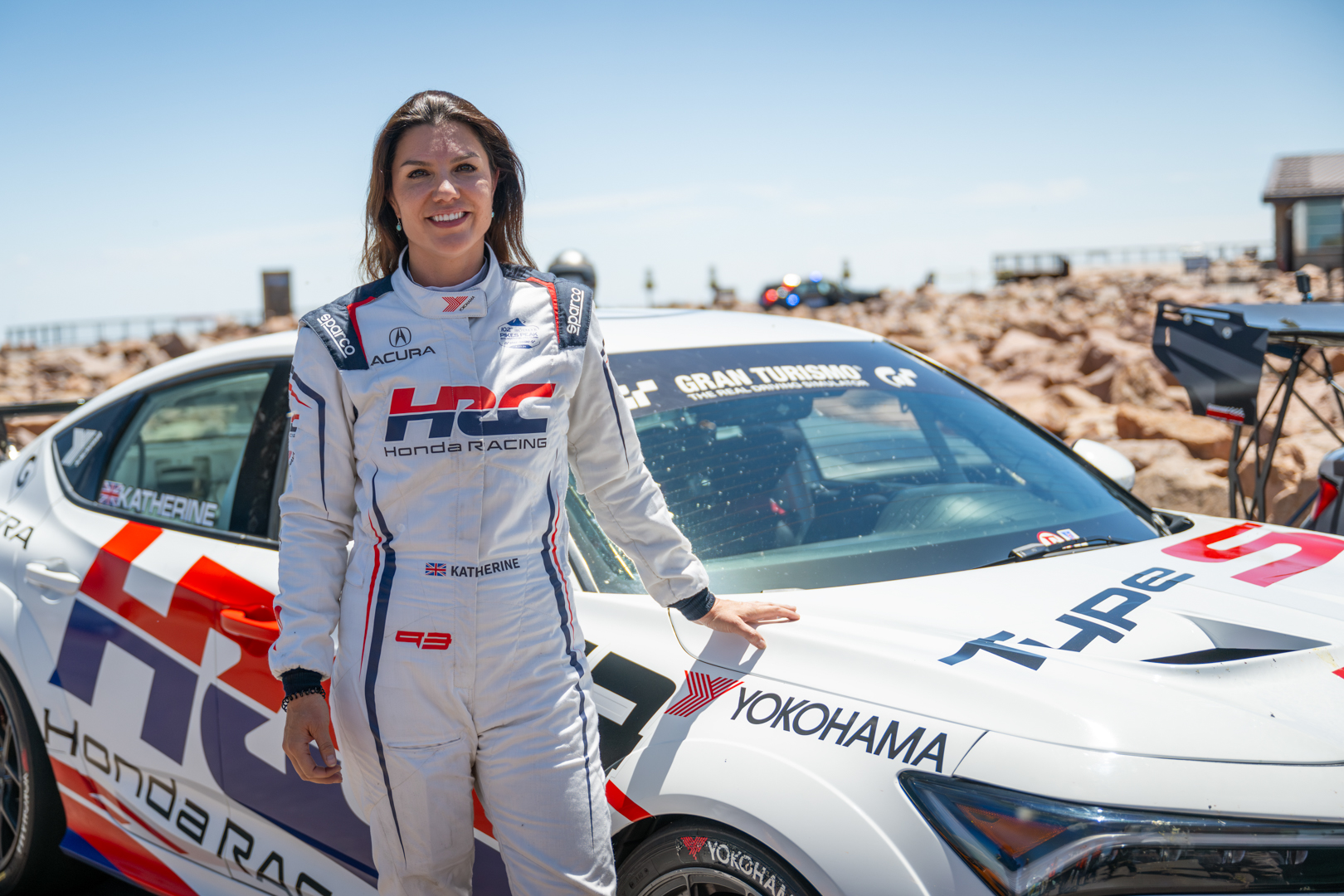

Katherine Legge walked into the hotel lobby, following her first-ever Pikes Peak Hill Climb, still wearing her racing suit, helmet in hand. Few hotel entrances go that hard. While the lobby wasn’t packed with people, the few who were eating dinner and having drinks couldn’t help but stare at the racing driver walking through. It was a rockstar moment. Thankfully, even after a long day on the mountain, Legge kindly agreed to talk to us about her first experience in one of the most iconic American races, her slightly disappointing time, why she decided to do Pikes Peak now, and whether she’ll be back.
“I have had a very diverse career in racing, probably one of the most diverse careers in racing,” Legge said. She ain’t kidding. Legge has raced in the Indy 500, IMSA, DTM, European Le Mans, Asian Le Mans, American Le Mans, Lamborghini Super Trophy, and NASCAR. If there’s a racing series with fast cars, there’s a good chance Legge has been behind the wheel at some point. But, until a few days ago, never Pikes Peak. So why now and what took so long?

“I love the history of racing and so I’ve always wanted to do it,” she said. Scheduling clashes with IMSA are what usually kept her out of Pikes Peak. But when it finally came time to charge up the hill, both the race’s history and danger suddenly became real. “I don’t even think I got the enormity of it, and the emotion that it evokes, until I was here and I drove up the mountain for the first time and had the biggest grin on my face and was like ‘This is the craziest shit I’ve ever done. What was I thinking? This is insane.’”
Even after an incredibly long and diverse career going very, very fast—Legge helped develop the freaking DeltaWing—Pikes Peak was the most challenging. “There is nothing that compares to the intensity and the focus and the adrenaline that this gives you. I think it’s probably because you can plummet 3,000 feet to your death at any second.”
It gets even harder considering there really isn’t any warm up to speak of. Sure, drivers run up the hill days before the race but the road is open to the public then, so they can’t practice at speed. They can drive as fast as is legally acceptable, and find some visual references for braking points and apexes, but they have to stay within their lanes, watching out for other cars. On race day, it can be tough to recall all of that information, since your first run up the mountain is your only one.


“You get one try. And you don’t get any practice. There’s no warm up, no settling in, no getting your tires warm like there is in all of circuit racing. You hit the start line, cold, after four hours of hanging around and eating barbeque.”
Earlier on race day, Legge told media that drivers will be happy if they know they did their best and didn’t leave any time on the track. However, that’s almost impossible at Pikes Peak. “Nobody can get 156 turns exactly spot on, right?”
Legge was a few seconds shy of the front-wheel drive record but she felt she probably left 30 seconds on the hill. “I tried too hard and I made mistakes. I’m kicking myself for it but I think, having been a rookie, now I know what I need to work on next year, to calm myself down and just focus on hitting my marks.”
She wouldn’t blame her car, though, the HRC-built Acura Integra Type R . “The car was excellent.” She said tire pressures could have been tweaked a bit better but that had more to do with unexpected weather. During the few days before the race, the weather was much colder toward the top of the mountain than it was on race day. And the road was greasier than expected, causing some oversteer. However, Legge praised the Acura team for constantly adjusting the car to her requests. “They’ve done such a great job with that front-wheel drive car. It’s unbelievable. Even tuning the turbo. On the middle section [of the hill climb], I was like ‘Hey, there’s some turbo lag in the W’s [switchbacks], I have to try and get on the throttle going into the corner, which gives me a bit of understeer. Is there anything you can do to spool the turbo up [earlier]?” Just a programming tweak gave Legge the earlier turbo boost she requested, which she says made her about five seconds faster.


How does a Pikes Peak first-timer adjust to the altitude, when climbing over 4,700 feet to a 14,100-foot summit? “I thought ‘I’m fit, I’m young, I got this, no problem,” she laughed. “It kicked my ass.” Thankfully, like most Pikes Peak drivers, Legge had oxygen on board.
She wasn’t the only one that struggled with the altitude. So did the car. “So they say that you lose almost 100 horsepower from the bottom to the top. And you can definitely feel it on the steep stuff as you get near the top.”
Is Legge going to be back next year? “Oh, I really hope so.” As long as it doesn’t clash with the countless other racing series’ she’s involved with, of course. “It will be priority because it’s so cool … I want to break that record and I want to break 10 minutes.”
Got tips? Send ’em to tips@thedrive.com